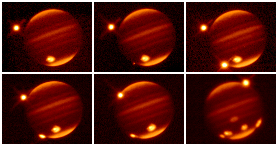

NOTE: Click on the images to view them at their highest resolution.
This is a six image sequence showing the collision of fragment H of Comet Shoemaker-Levy 9 with Jupiter. The frames were taken over a three hour period on the 18th of July, 1994, using the MAGIC infrared camera on the 3.5 meter telescope on Calar Alto. The star-like object next to Jupiter is the largest Galilean moon, Ganymede. The polar caps and pre-existing impact sites appear bright at the wavelength of observation, 2.3 microns, which was selected to maximize contrast between the impacts and the jovian cloud deck.
The following paragraphs give further information on each image.
Jupiter and Ganymede approximately four minutes prior to the impact of fragment H. The bright feature near the southern polar cap is the impact site of the D and G fragments, which struck the planet 32 and 12 hours earlier, respectively. Note the crescent shaped ejecta blanket to the southwest (lower right) of the D/G site.
The second and brighter of two impact precursors observed at Calar Alto. The first precursor appeared approximately two minutes earlier, and the main peak of the H impact began roughly four minutes after this exposure.
The main peak of the H impact approaches maximum light. The explosion brightened for another 4 minutes, during which time the MAGIC camera acquired near infrared spectra of the event. These spectra give strong indications of hot (>2000 K) molecular gas.
The fragment H impact site rotates into view. The scar on Jupiter's atmosphere is now larger than the planet Earth. Spectra taken just before this image show that the site has cooled considerably.
Appearance of the ejecta blanket. Forty five minutes after impact, the H collision site shows a second feature to the southwest. This is the crescent-shaped ejecta blanket similar to that seen in the pre-existing D/G site. Ganymede is just beginning its transit across the face of Jupiter.
The H impact site joins its brethren. More than three hours after impact, Ganymede has completed its transit, and the H impact site has rotated past the meridian and lies just to the southwest (lower right) of the Great Red Spot. This image was taken with the telescope pointed near the horizon, and the greater thickness of Earth's atmosphere renders the picture somewhat fuzzy. Nevertheless, the crescent-shaped ejecta blanket is obviously similar to that of the D/G impact (see adjacent frames). The sites visible on Jupiter are from left to right: A, E/F, H, and D/G (on the western limb).
Picture Credits:
Tom Herbst, Max-Planck-Institut fuer Astronomie, Heidelberg, Doug Hamilton, Max-Planck-Institut fuer Kernphysik, Heidelberg, Hermann Boehnhardt, Universitaets-Sternewarte, Muenchen, and Jose Luis Ortiz Moreno, Instituto de Astrofisica de Andalucia, Granada.